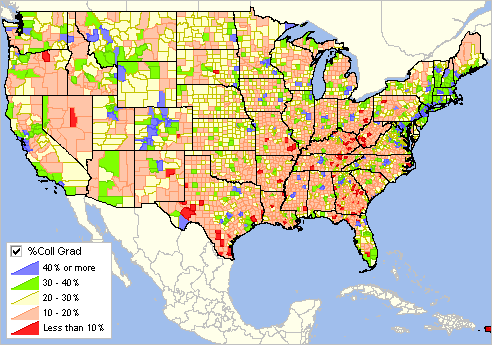

|
|
U.S. by County Social Characteristics -- ACS 2019 Household Composition, Education, Language, Related Attributes
June 2021 .. examining educational attainment ... Arlington County, VA has highest percent of college graduates among counties 50,000 population or more. See where counties of interest rank on this and other social characteristics measures using the interactive table below. Social characteristics of counties are essential for business development, market analysis, planning, economic development, program management and general awareness of patterns and trends. This section provides access to data and tools to examine these data for all counties in the U.S. This annual update includes characteristics for counties based on ACS 2019 data. Subscribe to demographic-economic estimates & projections to 2030 developed by ProximityOne. Details below. Use our data and tools to examine patterns, trends, characteristics and the how and why of change might affect stakeholder interests. Register for updates or e-mail us for more information. See these four related sections/tables organized by type of subject matter: • General Demographics • Social Characteristics-- this section • Economic Characteristics • Housing Characteristics Patterns of Percent College Graduates by County The following graphic shows percent college graduate population by county. Click graphic for larger view and details.  - View developed using ProximityOne CV XE GIS and related GIS project. Using the Interactive Table -- goto top Use the interactive table below to view, query, rank, compare social characteristics of the population for these areas. The scroll box shown below lists each of the subject matter items available for each area via the ranking table. In the subject matter items scrollbox, subject matter items are organized into to mini-tables with related items. The number at the left of the subject matter item is also used as the short name for the subject matter item in the column header in the ranking table.
U.S. by County Social Characteristics interactiive tables: General . Social (here) . Economic . Housing . Top Based on ACS 2019 Click ShowAll button between Find/Queries. Use mouseover on column header to view column description. See usage notes below table. See related tables -- interactive tables. Usage Notes • If table not showing any rows; click ShowAll button below table. • Use vertical and horizontal scroll bars to navigate up/down or left/right. • Adjust column widths using column divider between header cells. • StCty> button -- use to select one county -- one row appears in grid. .. get county 5-character code here .. paste the 5-character county code in the edit box to right of StCty> button. .. overwriting the value 48113. .. click the StCty> button ... table refreshes with the selected county. • CBSA> button -- use to select counties in a specified March 2020 vintage metro/CBSA .. get metro 5-character code here .. paste the 5-character metro code in the edit box to right of CBSA> button. .. overwriting the value 19100. .. click the CBSA> button ... table refreshes with all areas in specified metro. • Find Name> button -- use to select area based on exact spelling of partial name in column 1. .. Key in exact up/low case spelling of partial name of area in the edit box to right of Find Name> button. .. overwriting the value Dallas. .. click the Find Name> button ... table refreshes with all areas with matched spelling in column 1. • Selected columns -- "Pop.AvgHHSize.AvgFamSize.%HSGrad.%CollGrad" below the table to show only these columns; .. click "All columns" button to restore view to all columns. • All items are based on ACS 2019 5-year estimates. • Click ShowAll button between specific area queries. • Cells with negative value could not be estimated (for this geography and this time frame). Importance of Demographic-Economic Data The importance of understanding the demographic-economic make-up and trends can hardly be overstated. Community and educational challenges and opportunities are shaped by demographic-economic dynamics. Only by knowing "where we are" can we develop the most effective plans for improvement. The American Community Survey provides "richer" demographic-economic characteristics for national scope wide-ranging geographic areas. While Census 2010 provides data similar to those items in the General Demographics section, only ACS sourced data provide details on topics such as income and poverty, labor force and employment, housing value and costs, educational participation and attainment, language spoken at home, among many related items. The approximate 600 items accessible via the dataset are supplemented by a wide range of additional subject matter. These data are updated annually in December of each year for each/all political/statistical areas, including school districts, census tracts, ZIP code areas and block groups. ProximityOne User Group Join the ProximityOne User Group to keep up-to-date with new developments relating to metros and component geography decision-making information resources. Receive updates and access to tools and resources available only to members. Use this form to join the User Group. Support Using these Resources Learn more about accessing and using demographic-economic data and related analytical tools. Join us in a Data Analytics Lab session. There is no fee for these one-hour Web sessions. Each informal session is focused on a specific topic. The open structure also provides for Q&A and discussion of application issues of interest to participants. Additional Information ProximityOne develops geodemographic-economic data and analytical tools and helps organizations knit together and use diverse data in a decision-making and analytical framework. We develop custom demographic/economic estimates and projections, develop geographic and geocoded address files, and assist with impact and geospatial analyses. Wide-ranging organizations use our tools (software, data, methodologies) to analyze their own data integrated with other data. Follow ProximityOne on Twitter at www.twitter.com/proximityone. Contact us (888-364-7656) with questions about data covered in this section or to discuss custom estimates, projections or analyses for your areas of interest. |
|
|